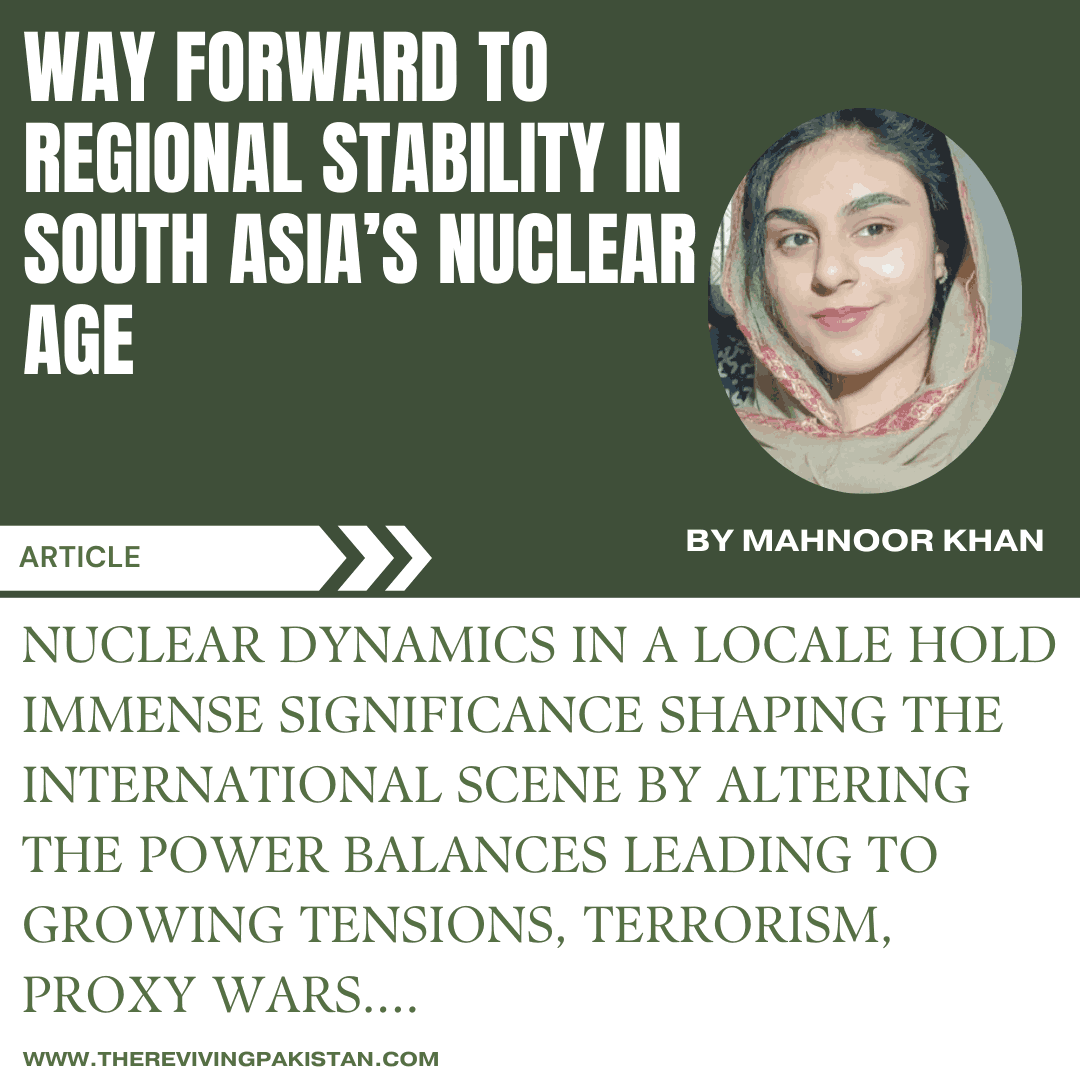About the Author(s)

Mahnoor Khan
Author is a student of BS International Relations at NDU. Writing is her passion which evolves from hobby. The ultimate goal of the author is to encourage the youth to never hesitate from sharing their revolutionary thoughts because success has never been achieved from the comfort of one’s couch!
Nuclear dynamics in a locale hold immense significance shaping the international scene by altering the power balances leading to growing tensions, terrorism, proxy wars using non-state actors, political instability, propriety impediment and a never ending arms race deterrent against potential adversaries. Besides, presence of these weapons in a region, raises the specter of nuclear expansion, accidental use and potential fallout from muddled episodes and impact of safety computations. In countries around the world the possession of nuclear arsenals significantly influences the interstate relations introducing a new layer of complexity and uncertainty.
As Robert J. Lifton said:
“I have in mind the spiritual aberration that I call nuclearism. We embrace the weapons for the purpose of safety and security and seek in the world going a form of salvation. Nuclear winter contributes to our imagination by making it clear that the end point of nuclearism is extinction.”
South Asia’s tryst with atomic age has been a complicated and unstable excursion set apart by international pressures, local fights for control and the journey for key predominance. The commencement of Nuclear age in South Asia can be followed back to May 18, 1974 when India directed its most memorable atomic test code named “SMILING BUDDHA”. This occasion stamped India’s passage into the nuclear hub. Pakistan intensified its pursuit of nuclear capabilities. Responding to India’s atomic aspirations, Pakistan heightened its quest for atomic capacities by culminating in its nuclear tests in May 1998 not long after India’s “Pokhran II” tests. These events irrevocably modified the locale’s security dynamics thrusting South Asia into a nuclear marathon.
Aristotle suggests that the beginning of wisdom is to classify, followed by the theories that more fully explain events, decisions and actions. The regions atomic scene has developed in the midst of verifiable struggles, persevering through several strains and international intricacies. The historical conflicts and enduring tensions within South Asia have been pivotal in the regions nuclearization. Deep rooted disputes, notably the Kashmir conflict between India and Pakistan and the fragile overall balance of power made an air of vital vagueness, prompting regular military stalemates coupled with the bitter legacies of multiple wars and sustained hostilities have been instrumental in propelling nuclear armaments. The 1947 partition and subsequent conflicts particularly Indo-Pak wars of 1965,close to war in 1987 again in 1999 and more recent skirmishes in Kashmir region intensified the quest for military parity and security guarantees aiming to counterbalance each other’s nuclear strength.
South Asian nations besides India and Pakistan, for example, Bangladesh, Bhutan, Nepal and Sri Lanka assume unmistakable parts in the local scene. Bangladesh known for its monetary regrowth underscores atomic innovation for tranquil purposes especially in energy and medical care and has reliably upheld for atomic demobilization. Bhutan is with its obligation to natural manageability and keeping an atomic free position centers around financial improvement directed by standards of Gross National Happiness. Nepal a signatory to NPT, highlights its commitment to an atomic liberated world focusing on financial progression and there is no proof of atomic weapons improvement or desire. Sri Lanka correspondingly dedicated to demobilization uses atomic innovation for clinical and farming applications. The nation has reliably underscored demilitarization and limitation. At this point their atomic strategies mirror a pledge to limitation and the serene utilization of nuclear innovation for financial turn of events.
The mere presence of these weapons in India and Pakistan and also the absence of hearty correspondence, channels the executive system between the two countries strengthening the potential for misconceptions and unintentional atomic acceleration leading to a complex web of strategic calculations.
The presence of atomic stockpiles in South Asia presents multi layered difficulties which certainly made South Asia a more dangerous place and possibly a less stable one where even a little atomic episode would deliver losses from remarkable greatness in the blink of an eye given the locale’s frail clinical and crisis foundation and targets close metropolitan regions.
Andrei Sakharov said that:
“A very large nuclear war would be a calamity of indescribable proportion and absolutely unpredictable consequences with the uncertainties tending towards the worst…all out nuclear war would mean the destruction of contemporary civilization, throw man back centuries, cause death of hundreds of millions of billions of people and with a certain degree of probability would cause man to be destroyed by a biological species.”
Nuclear use in south Asia would probably include counter worth targets on the grounds that both Indian and Pakistani munitions stockpiles are little and are decided to contain somewhat crude weapons any utilization of these on the enormous vigorously populated urban communities of the subcontinent would produce a requirement for requesting helpful operations, possibly including foreign military powers.
Provincial solidness in South Asia is critical for the general prosperity and progress of the countries in the area with different societies, chronicles and international intricacies and keeping up with the soundness requires key methodologies and aggregate endeavors which include empowering open correspondence and strategic exchange among south Asian countries.
Supported discretionary commitment among south Asian countries to cultivate open correspondence and exchange lessening the probability of misinterpretations and errors. In addition to this cooperative endeavors to address natural difficulties and infrastructure projects can add to security. Besides, putting resources into monetary relationship and Participation might actually divert the concentration from antagonism towards shared improvement and thriving.
According to Herman Kohn from a scientific perspective there is some indication that a nuclear war could deplete the earth’s ozone layer or less likely could bring on a new ice age therefore Atomic mishaps, radioactive garbage removal and the expected compassionate effect of atomic struggle requires World Wide collaboration and oversight. Participation in misfortune, medical services and destitution easing endeavors can fabricate generosity and collaboration can assist with building trust among countries and decrease the probability of misconceptions and errors. Moreover, dynamic commitment with worldwide associations and discussions can give a stage to south Asian countries but this upgrade urges responsibility and adherence to global standards.
Due to essential ramifications and potential outcomes related with nuclear capabilities, worldwide contribution in advancing limitations and demobilization endeavors assumes a vital part in forestalling multiplication of atomic weapons in south Asia and to address helpful and ecological worries related with atomic exercises. A number of factors including political will, state of current affairs, success with cooperative efforts and understanding of option and fear will help determine which activities can go forward. In the end there must be a recognition that cooperation and resolution of conflict are in the best interest of both parties.
Presently the three other super powers hold the power to neutralize the reaction on both sides. The issue requires a new approach by the P5s especially the US, who is exploiting the condition rather than containing it. The US is the only nation to have ever used nuclear weapons and presently spending $40 billion per annum on the maintenance and modernization of nuclear forces which gives other countries the justification to use nuclear weapons under the super power principle, “without nuclear power there is no security.” this comes as an important question in the minds of policy makers.
Global settlements and arrangements like the deal on the restraint[NPT] gives structure to advancing arm control which is the only tool available to control the spread of nuclear weapons therefore it is essential to implement it in a comprehensive manner. [NPT] has two objectives to achieve: Non-Proliferation and disarmament. There is a need to give equal preferences to both and ultimate objective should be the elimination of nuclear weapons rather than limiting their possessions. World Wide Associations like the International Atomic Energy Organization [IAEA] can help with checking and conforming the quite utilization of atomic innovation along with working with standard security discourse between south Asian countries to assemble trust, share security concerns and investigate amazing open doors for collaboration in regions atomic dependability. All in all global contribution is critical for empowering south Asian countries to partake in such arrangements and can add to a more secure and safer climate in south Asia. This actively demonstrates that cultivating public mindfulness and schooling on the outcomes of atomic struggle and significance of territorial security, informed popular assessment can impact strategic choices and elevate an aggregate obligation to harmony and peace.
To sum up all that has been stated so far the possible destiny of south Asia’s nuclear age is complicatedly shaped by a blend of worldwide innovative and discrete factors. The region’s components depend on enduring through strains among India and Pakistan with potential forward leaps reliant upon having a tendency to focus topics like Kashmir by political endeavors and worldwide security contemplations, adhering to NPR and NPT which would clear a path for south Asia’s provincial solidness in its pinnacle atomic period.

